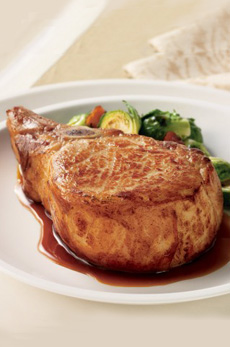|
Become a sauce master: Here’s Part 3 of chef Johnny Gnall’s tutorial on the secondary sauces. Start at the beginning with:
The Five Mother Sauces
Secondary Sauces: Bearnaise and Creole
Secondary Sauces: Cheddar Cheese Sauce and Sauce Suprême
If you have questions or suggestions for other tips, email Chef Johnny.
ESPAGNOLE SAUCE BECOMES DEMI-GLACE
Demi-glace (pronounced DEH-me GLAHS) is a rich brown sauce that is often served with beef, lamb and pork. The term comes from the French word glace, which means icing or glaze (among other things, including ice and ice cream); demi means half. Demi-glace is thicker and contains more gelatin than espagnole alone, so it has more body.
Demi-glace is traditionally made by combining equal parts veal stock or other brown stock and the mother sauce, espagnole.
Then reduce the liquid by half and strain through a fine sieve or cheesecloth.
|
|

A Berkshire pork chop atop a demi-glace sauce. Photo courtesy AllenBrothers.com. |
|
Marchand De Vin Sauce
A variation of demi-glace is sauce marchand de vin (marchand de vin is French for wine merchant), which, not surprisingly, includes wine.
Combine 3/4 cup red wine and one minced shallot; reduce by three fourths.
Whisk in a quart of demi-glace; reduce, simmer and season to your liking.
You now have a sauce that is perfect for pretty much any meat you can cook up!
Beyond the myriad classic sauces that stem from espagnole sauce, I am always up for some boundary crossing between cuisines—otherwise known as fusion food. I am a big fan of taking this classic French sauce and bringing it down to Mexico.
Mole Sauce
By adding a little cocoa powder and very little chile powder to a quart of espagnole sauce, you turn it into variety of mole sauce.
Start with 2 tablespoons cocoa and 2 teaspoons chile powder; add both in small doses to the sauce until you achieve your liking. Depending on how much you use, cocoa has a distinct and earthy flavor that can exist in the background or take over the stage (so bear that in mind as you add it).
You can also sweeten the sauce to your liking. I suggest using palm sugar or brown sugar, as sweeteners with color often have a bit of character that can add another bit of complexity to the sauce. Just remember to always add ingredients in small amounts and taste often in order to get the flavor profile just right. Reduce at a simmer if you’d like to thicken your sauce or intensify the flavors, season with a pinch or two of salt, and you’re ready to go.
This variation of mole is not precisely the traditional Mexican procedure, but nobody will be complaining.
My mom, who grew up in Mexico, serves her mole sauce with lamb chops and mashed potatoes.
Whip some goat cheese into the mashed potatoes.
Marinate the lamb chops with some sherry vinegar: The tartness on the lamb chop alongside the creamy mashed potatoes, all drizzled with that sweet, earthy sauce, comes together like a symphony in your mouth.
|
